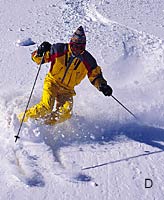Powder Principles: Law 4-Tactics

Tactics¿your line of attack on a powder run¿are as much about psychology as skill. The hapless skier in the sequence above is struggling because he approached the slope too timidly and indirectly. As Steve advises, “Find your comfort zone¿a gentle enough pitch where you can find rhythm and not be afraid to stay in the fall line.”
Look at the tracks our novice has made. Because the slope seems too steep to him (or the powder too deep), he starts out tentatively¿across the hill in a traverse (A). He makes a sharp turn into another traverse, and here we’ve caught him in his third traverse (B). Because he’s going so slowly and has to make such a sharp turn¿almost 180 degrees¿to traverse in the other direction, neither he nor his skis ever generate enough speed to power through the snow. His turn (B) is nothing more than a weak lurch.
Now look at Steve’s tracks (C). He “points ’em down,” right into the fall line. This commitment to the slope provides him the speed to get his skis floating and his legs working. The result is a relaxed descent and elongated, rounded arcs.
Your tracks are an indelible report card on your run. Start in the fall line, get some speed, and scribe round tracks you can be proud of.
Powder Myth No. 2: Don’t Skid in Powder
Many skiers believe that narrow, carved tracks are a must in powder; make wide tracks, and you risk catching an outside edge and falling headlong over your downhill ski. Junior doesn’t subscribe to that belief. “Skidding happens a lot in powder,” he insists, “especially where it’s steep and you need to control speed (See law 6).”
Junior’s theory is that when a ski skids in powder, its outside edge floats toward the surface. The wider the ski, the more readily the outside edge rises. Junior is making wide, skidded tracks (D). We see his skis drifting sideways through the snow. His outside edges are floating above harm’s way, meaning he won’t get snagged by the powder itself.